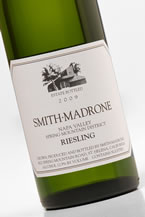|
|
 |

Smith-Madrone, Napa Valley-Spring Mountain District (California) Riesling 2012 ($27): I can count on one hand and maybe a couple of fingers the Riesling wines from California that I admire, and most of them come either from Anderson Valley or Monterey. An impressive Riesling from Napa Valley is a rare bird. But then so is Stu Smith who, with his brother Charles, owns and farms the Smith-Madrone estate high on Spring Mountain in western Napa Valley, where vines occupy steep slopes from 1300 to 2000 feet in altitude, some of them dating back to the original estate planting in 1972. The artisanal winery produces a mere 4000 cases a year, only Riesling, Chardonnay and Cabernet Sauvignon, all from dry-farmed vines. original estate planting in 1972. The artisanal winery produces a mere 4000 cases a year, only Riesling, Chardonnay and Cabernet Sauvignon, all from dry-farmed vines.
I have been following Smith-Madrone’s Riesling in particular for fifteen years or longer, and this wine has always intrigued me. It is a Riesling that’s very pretty when it is young, very easy to enjoy, and yet it ages very well, developing complexities that were not evident amidst the charms of the young wine.
Nine of the estate’s 34 vineyard acres are now planted to Riesling. (Cabernet Sauvignon has the lion’s share, 13 acres, while Chardonnay claims slightly more than 10 acres, with Merlot and Cabernet Franc making up the balance, as blending grapes for the Cab.) The Riesling vines occupy a cool, east-facing ridge of the estate. The initial Riesling plantings occurred in 1972, using a Geisenheim clone, and were own-rooted. Subsequent plantings since the turn of the century, when the estate experienced phylloxera, came from the estate’s original plant material grafted onto resistant rootstock.
Many of my tasting notes for Smith-Madrone Riesling over the years describe the wine as slightly off-dry, but this 2012 has only 3.5 grams of residual sugar (RS) -- certainly a dry wine. Stu explained that he and his brother have always made all their wines to suit their own taste; in Riesling, that taste has slowly evolved from an off-dry style with about 15 to 17 grams of RS forty years ago to a dryer style with about 11 or 12 grams and then, for the past ten to twelve years, a style with less than 10 grams RS, generally 6 to 6.5 grams. In 2012, the Riesling ended up dryer than that, one of the “lovely imponderables” of wine, in Stu’s eyes.
This 2012 Riesling, despite being technically dry, has such exuberant fruitiness that it does not taste at all severe or angular. The wine is medium-bodied, with crisp acidity that hides behind the wine’s fruitiness but reveals itself in mid-palate depth and a long thrust of flavor across your mouth and into the finish. The wine’s texture is silky, shot through with energy from the acidity. Aromas and flavors suggest white peach, green apple, lime and melon; if “minerality” were not a problematic descriptor these days, I would say that the wine also has that character, a chalk-like, tactile nuance.
In tasting Riesling, it’s tempting to characterize wines stylistically as Germanic or Alsace-like, or even Australian. This wine does not easily fit any of those models. It is lighter and subtler than a Clare Valley Riesling, for example. It is fruitier, less earthy and less hefty than an Alsace Riesling. My closest comparison would be a Mosel Riesling, for its vivid expression of fruit and its charm, and yet at 12.5 percent alcohol this wine is bigger and somehow more commanding, and it has more gravitas. The point of this exercise is to suggest that if you enjoy Riesling, you should try this wine and have fun characterizing it for yourself, because it is an American original.
This is a small-production wine, only 463 cases in 2012. It is undeniably drinkable now, but in my opinion it will evolve for up to ten years.
91 Points
|
 |
|